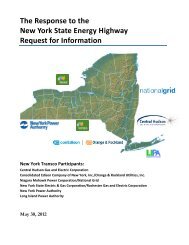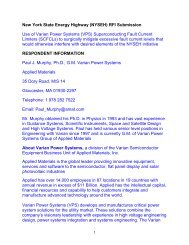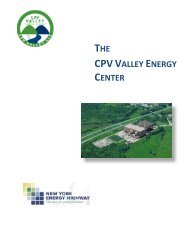Silicon Solution Joint Venture, LLC - Energy Highway
Silicon Solution Joint Venture, LLC - Energy Highway
Silicon Solution Joint Venture, LLC - Energy Highway
You also want an ePaper? Increase the reach of your titles
YUMPU automatically turns print PDFs into web optimized ePapers that Google loves.
US SOLAR – WHITE PAPER 24 May 2012<br />
• Sanction liquid, tax-advantaged vehicles: Whether they take the form of renewable MLPs<br />
or S-REITs, vehicles that allow investors to buy shares in public markets, offer tax-efficient<br />
financing to the sector, and are without an illiquidity premium have the potential to expand the<br />
base of investors and lower the cost of capital. Of the two, S-REITs seem more politically<br />
viable, as they can be implemented without legislative change and do not entail butting heads<br />
with deficit hawks.<br />
As an initial approach, usages of the S-REIT structure may simply feature the bundling solar<br />
systems as part of an existing REIT-eligible real estate property. The longer term play, though,<br />
is to enable the creation of pure play S-REITs: funds composed entirely of solar assets.<br />
Realising these kinds of structures would require that PPA revenues earn qualification as<br />
'rental income' and likely also that solar equipment earn qualification as part of property.<br />
A final wrinkle to be smoothed to further pave the way for S-REITs, would be to allow for<br />
production-based tax credits (PTC) in lieu of ITCs for solar. According to advocates of this<br />
idea, the steady long-term drip of PTCs would more suitably fit the cash flow profile of a<br />
dividend-yielding REIT than would a large lump-sum payment of the ITC. However, this would<br />
also expose an investor to performance risk.<br />
7. NEAR TERM: CONSOLIDATION ENABLES EVOLUTION<br />
Sector consolidation will<br />
enable these<br />
innovations in solar<br />
financing<br />
The evolution that has been described throughout this paper is one that we expect to unfold in the<br />
medium term, over the next several years. For this to happen, however, in the nearer term, the<br />
make-up of the US solar industry will itself need to evolve. Specifically, sector consolidation will<br />
enable these innovations in solar financing.<br />
The industry will likely transition from one with many small players – particularly in the residential<br />
and commercial markets – to one that will have small number of large and well-capitalised<br />
players. The expiration of the cash grant will accelerate industry consolidation. Smaller<br />
developers who thrived on the grant will not be able to raise tax equity because providers have<br />
minimum investment thresholds of $15-30m or more. Additionally, smaller developers are typically<br />
unable to provide indemnification for tax equity providers who are looking to protect themselves<br />
against the risks of ITC recapture (recapture may be triggered by circumstances such as<br />
foreclosure on the property on which the solar project sits). Sponsor size matters, and smaller<br />
developers unable to raise tax equity may not be able to stay in business.<br />
Consolidation will facilitate the emergence of investment options that require scale such as assetbacked<br />
securities or ‘yieldco’ issuances. It will lower risks for investors, and lead to a decrease in<br />
cost of capital. Consolidation may particularly benefit the commercial market. Large third-party<br />
financiers such as SolarCity are well-versed in obtaining tax equity finance for the residential<br />
market, and large developers such as NRG are similarly equipped for utility-scale projects.<br />
However, the commercial space has been largely neglected by tax equity investors, as project<br />
developers today are too small to provide standardised commercial PPA contracts that are more<br />
complex than residential PPAs and generally too small to offer indemnification to tax equity<br />
investors. In a consolidated industry, developers may have the scale to raise tax equity for<br />
commercial-scale projects.<br />
Even with consolidation, it is unclear if the tax equity ‘majors’ will be willing to finance small<br />
distributed solar projects. Many providers only have experience with utility-scale projects and may<br />
be turned off by the due diligence involved with small projects or portfolios. In the near-term this<br />
may require new entrants to finance these deals as well as potentially tax equity guarantors to<br />
protect investors against the risk of ITC recapture.<br />
© Bloomberg New <strong>Energy</strong> Finance 2012<br />
Strictly no copying, forwarding, shared passwords or redistribution allowed without prior written permission<br />
of Bloomberg New <strong>Energy</strong> Finance. For more information on terms of use, please contact<br />
sales.bnef@bloomberg.net. Copyright and Disclaimer notice on page 28 applies throughout. Page 25 of 28














